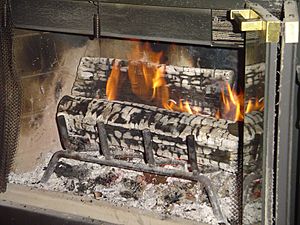Chemical change facts for kids
A chemical change (chemical reaction) is a change of materials into other, new materials with different properties, and one or new substances are formed. Burning of wood is a chemical change as new substances which cannot be changed back (e.g. carbon dioxide) are formed. For example, if wood is burned in a fireplace, there is not wood anymore but ash. Other examples include burning of a candle, rusting of iron, baking a cake, etc. Special details that describe how a chemical change takes place are called chemical properties.
Compare: Physical change - The opposite of a chemical change is a physical change. Physical changes are a change in which no new substances are formed, and the substance which is changed is the same. For instance, if a stick of wood is broken, there is still a stick of wood; it is just broken.
More examples include changes of shape, changes of states, passing electricity through a copper wire, breaking of wood, shattering of glass, pouring of water, etc. Special details which do not change in a substance without new substances being formed are called physical properties.
Contents
Types
Chemists categorize chemical changes into three main classes: inorganic chemical changes, organic chemical changes and biochemical changes.
Inorganic changes
Inorganic chemistry describes the reactions of elements and compounds that, in general, do not involve carbon. The changes typically take place in laboratories, or on a larger scale in heavy industries.
Typical types of change include neutralization (mixing an acid with a base, resulting in water and salt), oxidization including combustion, redox reactions etc.
Organic changes
Organic chemistry is concerned with the chemistry of carbon and the elements and compound with which it reacts. These compounds include mineral oil and all of its products and much of the output of industries manufacturing pharmaceuticals, paints, detergents, cosmetics, fuels etc. Typical examples of organic chemical changes include cracking heavy hydrocarbons at an oil refinery to create more gasoline from crude oil, as gasoline is in higher demand than the heavier hydrocarbons, such as residual fuel oils. Other reactions include, methylation, condensation reactions, polymerisation, halogenation etc.
Biochemical change
Biochemistry deals with the chemistry of the growth and activity of living organisms. It is a chemistry where most reactions are controlled by complex proteins called enzymes and are moderated and limited by hormones. The chemistry is always highly complex and is still not fully understood. Decomposition of organic material is also within the scope of biochemistry although in this case it is the growth and activity of fungi, bacteria and other micro-organisms that is involved. Typical types of change include the processes involved in photosynthesis, a process in which carbon dioxide and water are changed into sugars and oxygen by plants, digestion in which energy rich materials are used by organisms to grow and move, the Krebs cycle which liberates energy from stored reserves, protein synthesis which enables organisms to grow using processes controlled by RNA, etc.
Evidence of a chemical change
The following can indicate that a chemical change has taken place, although this evidence is not conclusive:
- Change of odor.
- Change of color (for example, silver to reddish-brown when iron rusts).
- Change in temperature or energy, such as the production (exothermic) or loss (endothermic) of heat.
- Change of composition - paper turning to ash when burned.
- Light and/or heat given off.
- Formation of gases, often appearing as bubbles in liquids.
- Formation of a precipitate (insoluble particles).
- The decomposition of organic matter (for example, rotting food).
- The change is difficult or impossible to reverse.
See also
 In Spanish: Reacción química para niños
In Spanish: Reacción química para niños


